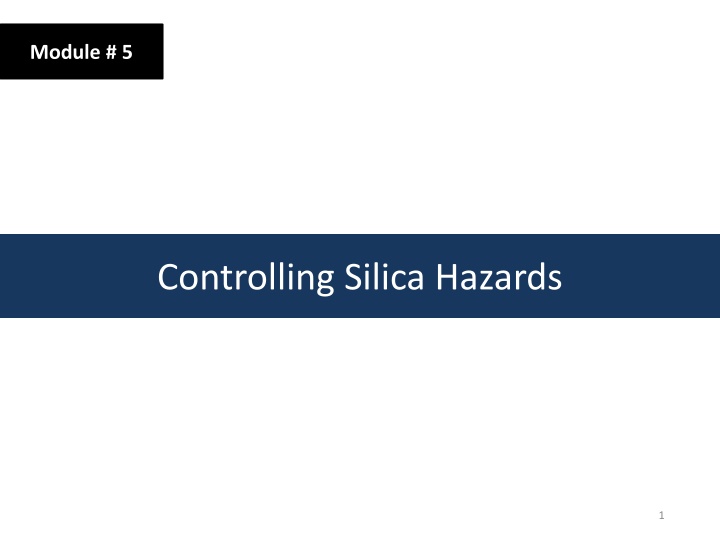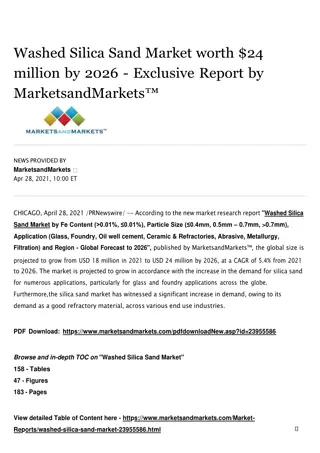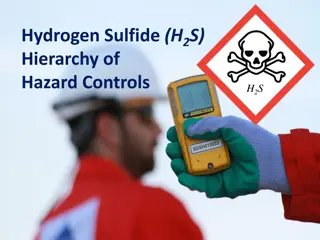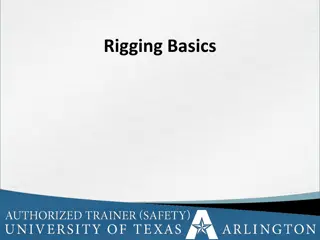Controlling Silica Hazards: Effective Engineering Controls
Techniques for controlling silica hazards in the workplace include elimination, substitution, and engineering controls like ventilation, dust containment systems, wet methods, and housekeeping practices. Elimination involves removing silica exposure risks, while substitution replaces risky materials. Engineering controls focus on reducing silica dust levels, such as using local exhaust ventilation and wet methods to prevent dust dispersion.
Download Presentation

Please find below an Image/Link to download the presentation.
The content on the website is provided AS IS for your information and personal use only. It may not be sold, licensed, or shared on other websites without obtaining consent from the author.If you encounter any issues during the download, it is possible that the publisher has removed the file from their server.
You are allowed to download the files provided on this website for personal or commercial use, subject to the condition that they are used lawfully. All files are the property of their respective owners.
The content on the website is provided AS IS for your information and personal use only. It may not be sold, licensed, or shared on other websites without obtaining consent from the author.
E N D
Presentation Transcript
Module # 5 Controlling Silica Hazards 1
Disclaimer This material was produced under grant number SH-05053-SH8 from the Occupational Safety and Health Administration, U.S. Department of Labor. It does not necessarily reflect the views or policies of the U.S. Department of Labor, nor does mention of trade names, commercial products, or organizations imply endorsement by the U.S. Government. 2
Elimination Elimination means to eliminate job tasks with risk of silica exposure. The most effective way to eliminate the silica hazard is to eliminate the silica! This could include design changes and modifications to equipment, systems, and processes in order to eliminate the source of exposure Examples: i. Redesign to comply with this requirement ii. Preparation of execution methodology using silica free equipment 4
Substitution Substitution of means to replace the means and methods of the job tasks with risk of silica exposure. This control method is applied principally during operational stage to modify the risks that were not addressed in the initial design processes. Examples: i. Replace crystalline silica materials with non-crystalline-silica materials ii. Especially important for sandblasters, where the abrasive blasting (severe silica exposures) is often done outside and in different locations, making it impossible to install an engineering control. 5
Engineering Controls To Reduce Silica Dust Levels 1. Ventilation You can stop silica dust dispersion before it starts using local exhaust ventilation (LEV). 2. Dust containment systems There are several types of dust containment systems. The right one for you depends on the design of your facility, your applications, and your assessed risk, among other factors. 3. Wet methods Wet methods involve spraying water (or another liquid agent) on an area before performing a task that generates dust, like drilling or cutting. 4. Housekeeping Methods Approved housekeeping methods are wet methods (i.e., using water to keep dust down) and vacuuming using equipment that meets strict filter requirements. 6
Engineering Control (1) Dry Conditions vs Wet System 7
Engineering Control (2) No Dust Control vs Dust Control 8
Housekeeping Dry sweeping or dry brushing where such activity could contribute to employee exposure shall NOT be allowed unless wet sweeping, HEPA-filtered vacuuming or other methods that minimize the likelihood of exposure is not feasible. Compressed air shall NOT be used to clean clothing or surfaces where such activity could contribute to employee exposures unless; The compressed air is used in conjunction with a ventilation system that effectively captures the dust cloud created by the compressed air; or No alternative method is feasible. 9
Administrative Controls (1) Administrative Controls are a set of policies, procedures and work practices which include: i. Work schedules/job rotation ii. Staffing levels iii. Maintenance iv. Supervision v. Inspections vi. Job hazard analysis vii. Housekeeping viii. Providing shower/washing/eating facilities ix. Signage 10
Administrative Controls (2) If workers know about silica and understand the severity of its health hazard, they will be more likely to do the following: i. Know which work operations can lead to silica exposure ii. Participate in any air monitoring or training programs offered by the employer iii.Limit time spent working with Respirable Crystalline Silica, and/or limit worker access to areas of high RCS concentration iv.If possible, change into disposable or washable work clothes at the worksite; shower (where available) and change into clean clothing before leaving the worksite. v. Do not eat, drink, use tobacco products, or apply cosmetics in areas where there is dust containing crystalline silica. 11
Personal Protective Equipment PPE against silica is used when unable to eliminate or reduce the hazard sufficiently. PPE against silica includes respirators and masks. osha respirators Respirators should be used only when the dust controls cannot keep dust levels below the OSHA s Permissible Exposure level (PEL). For respirators to work properly, they must be selected for each worker, individually fitted and periodically refitted, and regularly maintained, which includes replacing filters and other parts as necessary. 12
Respiratory Protection Program An effective respirator program must cover the following factors: Written worksite specific procedures Air quality standard Medical evaluations Training Fit testing Selection of an appropriate respirator approved by the National Institute for Occupational Safety and Health (NIOSH) Inspection, cleaning, maintenance, and storage Work area surveillance Program evaluation 13
Air-purifying Respirators (1) There are four NIOSH-approved respirators for controlling silica dust on construction sites: 1) Filtering Facepiece Respirators 2) Elastomeric Half Facepiece Respirators with P100 filter 3) Elastomeric Full Facepiece Respirators with P100 filter 4) Powered Air-Purifying Respirator (PAPR) with P100 or HEPA filter. Respirator selection depends on the amount of exposure. 14
Air-purifying Respirators (2) Filtering Facepiece Respirators Disposable N95 respirator The minimal acceptable respirator N95 is a term referring to the N95 filter class, which removes at least 95% of airborne particles. The OSHA Assigned Protection Factor (APF) is 10 The FFR classes include N (not resistant to oil), R(somewhat resistant to oil), and P(strongly resistant to oil) series, which are available at 95, 99, and 100 filtration efficiency levels 15
Air-purifying Respirators (3) Elastomeric Half Facepiece Respirators Elastomeric half facepiece and quarter facepiece respirators are reusable devices with exchangeable cartridges or filters. The Assigned Protection Factor (APF) is 10. Elastomeric Full Facepiece Respirators Elastomeric full facepiece respirator is a reusable device. This type of respiratory protective device uses exchangeable cartridges, canisters, or filters. The Assigned Protection Factor (APF) is 50. 16
Assigned Protection Factor (1) Assigned Protection Factor (APF) means the workplace level of respiratory protection that a respirator is expected to provide to employees. APFs are used specifically to select the appropriate class of respirators that will provide the necessary level of protection. Employers must provide respirators that are adequate to protect employee health and ensure compliance with all OSHA requirements under routine, and reasonably foreseeable, emergency situations. 17
Assigned Protection Factor (2) An APF of 10 means that dust masks (if used properly) can be safely used in an atmosphere that has a hazardous concentration of up to 10 times the Permissible Exposure Limit (PEL) or other exposure limit for that hazard. 18
Choosing The Correct Respirator Choosing the right equipment involves: i. Determining what the hazard is and its extent ii. Considering user factors that affect respirator performance and reliability iii.Selecting an appropriate NIOSH-certified respirator Users should know that improper respirator use or maintenance may cause overexposure. They also should understand that continued use of poorly fitted and maintained respirators can cause chronic disease or death from overexposure to air contaminants 19
Training For Respirator Use Training must include an explanation of the following: Why respirator use is necessary Nature of the respiratory hazard and consequences of not fitting, using, and maintaining the respirator properly Reason(s) for selecting a particular type of respirator Capabilities and limitations of the selected respirator How to inspect, put on and remove, and check the seals of the respirator Respirator maintenance and storage requirements How to use the respirator effectively in emergency situations, including when the respirator malfunctions How to recognize medical signs and symptoms that may limit or prevent the effective use of the respirator 20
Review & Questions Name three important things you learned in this section. 21























